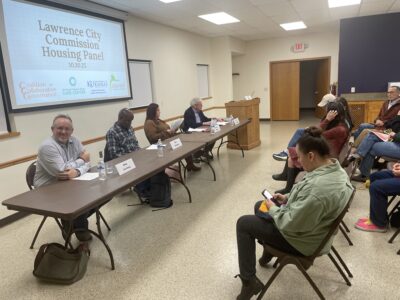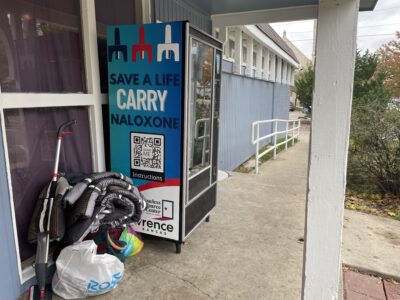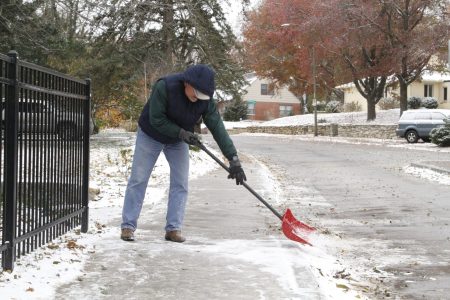Spending some reserves, lowering pay raises, keeping 4-person fire crews — here’s what city commissioners want changed in the 2025 budget

photo by: Screenshot
Commenters fill the Lawrence City Commission meeting room for the city's budget hearings on Tuesday, Aug. 20, 2024.
A couple of fire station projects would happen later. Staff raises wouldn’t be as big. And the city would dip into some special funds to pay for playgrounds at some city parks.
Those are among the changes that the Lawrence City Commission has asked staff to make to the 2025 budget plan after hearing dozens of residents voice their frustrations with proposed tax increases and service cuts at a public hearing this past week.
The budget is scheduled for a final vote on Sept. 3, and the version originally proposed by City Manager Craig Owens would raise the mill levy from the 2024 rate of 33.207 mills to 36.807 mills — the highest mill levy increase in at least 50 years, as the Journal-World has reported. It also would have made cuts to fire and medical staffing and the Parks and Recreation department, which together with the tax hike sparked an outcry from many in the community.
The commission at its meeting on Tuesday heard those concerns in more than an hour’s worth of public comments, and commissioners gave city staff guidance on a few ways to possibly reduce the tax hike and avoid some of the most painful cuts.
Commissioner Brad Finkeldei summarized the recommendations: postpone funding for two new fire stations, keep firefighter staffing at levels that would allow for four people per truck, use reserve dollars where possible to limit a tax increase, make cuts to a proposed cost-of-living adjustment for staff, and allow Parks and Recreation to use some reserve balance to help fund the replacement of some closed playgrounds.
Here are some of the highlights of the proposed changes and what impact they might make on the budget and residents’ tax bills.
• • •
Impacts to Lawrence-Douglas County Fire Medical were among the most visible changes in the initial proposed budget.
As previously reported, that proposal would have reduced firefighter staffing on each truck from four people to three as a way to help fund the construction of two new fire stations in the city.
Across multiple City Commission meetings, dozens of firefighters have spoken out against the proposed drop in staffing. The city provided a different option that would restore the staffing to four on each truck and add a deputy chief, but that option would require about 1.3 mills.
Commissioners were unanimous in looking to restore the staffing for the fire trucks, and Commissioner Amber Sellers suggested using fund balance, a rainy day fund, to cover the cost for the LDCFM restoration and “minimize the mill increase.”
Finkeldei said that would have about a total impact of $1.8 million coming out of the city’s general fund balance.
Additionally, Finkeldei and other commissioners also said the city “needed to figure out” the future of two proposed fire stations in the coming years. The new stations are seen as important for the city — LDCFM Chief Rich Llewellyn said back in July that they would be “critical” — but Finkeldei said with the lack of funding there might need to be a reevaluation of what the stations might look like and “how (they) are going to pay for it.”
Commissioner Mike Dever said the city would need to take a serious look at what kind of fire protection and prevention was really necessary in the community. He said the city might need to “right-size” its services and explore what it can do while staying within the budget.
“Do we really want two new fire stations, or do we need more EMS stations?” Dever asked.
As part of the discussion, the commissioners asked to push back funding set aside for the new stations, Stations 6 and 7, in the city’s Capital Improvement Plan for one year. Currently, there is $1,540,000 in 2025, $5,420,000 in 2026 and $5,700,000 in 2027 allocated for Station 6; there is $2,640,000 in 2028 and $13,860,000 in 2029 for Station 7.
Alley Porter, a budget manager with the city’s finance department, told the Journal-World that pushing those projects out one year will reduce the combined operating budget for 2025, and the department is updating the budget impact accordingly ahead of the final budget proposal.
• • •
As the commissioners were looking for additional cuts, Dever mentioned exploring a decrease to the cost-of-living adjustments for city staff.
The city allocated $5 million in raises for employees in both its 2022 and 2023 budgets, and getting pay to market levels has been a focus for the city in recent years.
Dever said he believed that city staff was well taken care of and that the city had done a good job of compensating employees, but he was worried that the increase in the payroll could be “unsustainable.”
“If we need to start finding money, a decrease to cost-of-living increases can help,” Dever said.
Porter said the city is estimating a 1% decrease in the market adjustment rate would cut $450,000, with approximately $200,000 being from the primary pay plan, which are nonunion employees. Porter said $200,000 would be cut out of the general fund expenses with this move.
• • •
As seen with the suggestion for the fire department funding, commissioners are interested in using reserve fund balances to try to fund programs while not increasing taxes.
Another area suggested by the commissioners was to allow the Parks and Recreation department to use special funds to replace some closed playgrounds.
As the Journal-World has reported, the cuts proposed for the Parks and Recreation department included removing a fund that helped the department replace aging structures.
Earlier in August, four old play structures at Park Hill Park #1 and Chaparral Park were closed off with tape and “No Trespassing” or “Keep Out” signs. Three other parks, Clinton Outlet Park, Broken Arrow Park and McSwain Park, could also have had their structures closed.
After the commission authorized using special funds to replace and repair playgrounds, Porter said the city would now be able to add some new structures at the parks using the Special Recreation Fund.
There were other funds the commission authorized the city to use in some cases, but that wouldn’t necessarily impact mill rates, Porter said.
• • •
One thing that was brought up on Tuesday was that these measures are mostly stopgaps, and the city will have to come up with more permanent budget solutions or face similar problems in future years.
Commissioner Lisa Larsen said that could mean taking a much harder look next year at the budget for 2026.
“We need to change the way we are doing our budget and actually take a look at programs, and I’m seeing the need to potentially wholesale cut some programs … out of what we do as a city,” Larsen said. “Is it really a need for us, is it part of our strategic plan — we need to have a discussion about that.”
She said that “we need to look at every single program in our city and say, ‘Is this really our job? Is this our purview?’ and decide from there whether or not we should fund those.”
And Larsen also told Owens that those conversations need “to really start early, and not … when you present our budget in July.”
Owens said that the city had tried to invite the public to participate in the process early on. He specifically mentioned tools like the online budget simulator “A Balancing Act,” which allows residents to create their own version of the budget and share what they would prioritize.
But he also acknowledged that the kinds of deeper conversations that Larsen was talking about would require the city to rethink its processes.
“We need to create a process that lets us have those conversations, because that’s not how the budget conversations have gone (in) the time I’ve been here,” Owens said.







